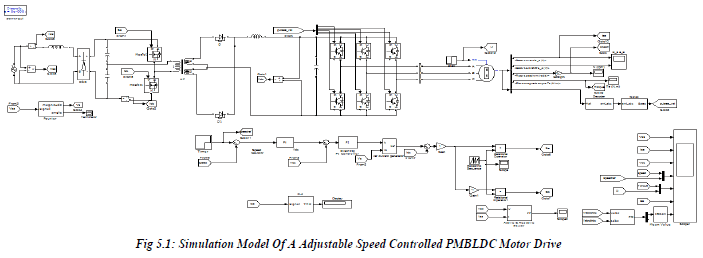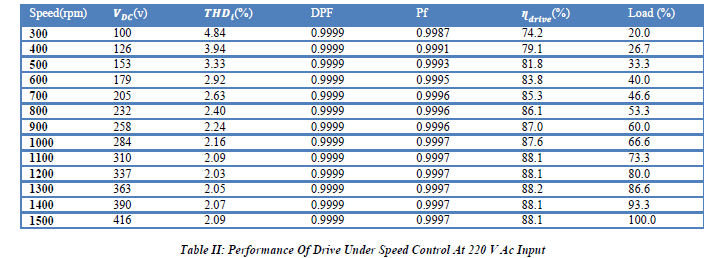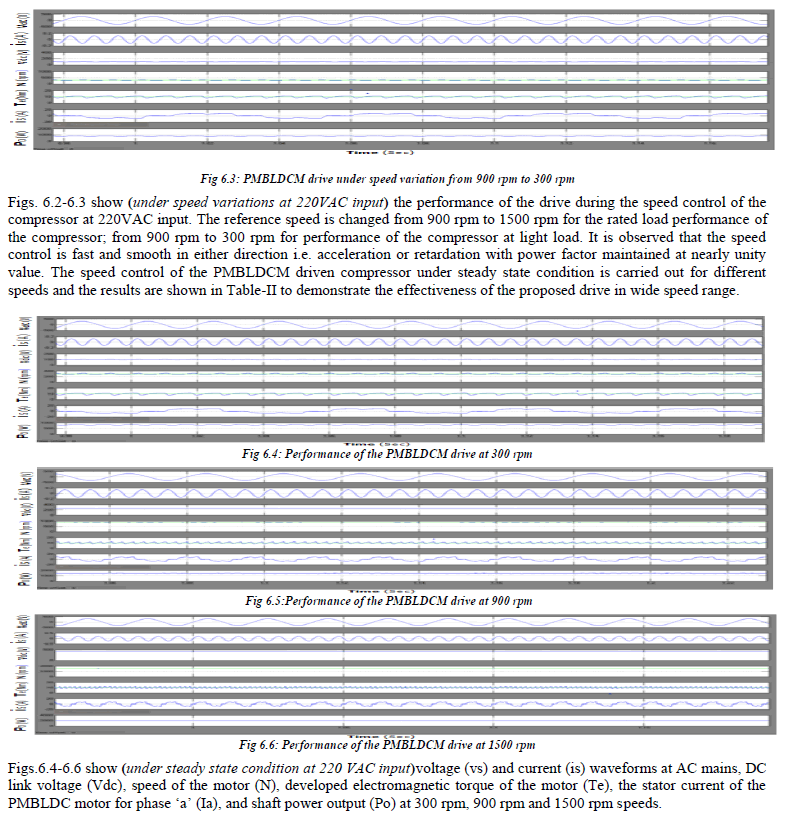ISSN ONLINE(2319-8753)PRINT(2347-6710)
ISSN ONLINE(2319-8753)PRINT(2347-6710)
Dichendra Kumar Gonu1, Rajasekharachari k2, C.B.Saravanan3
|
| Related article at Pubmed, Scholar Google |
Visit for more related articles at International Journal of Innovative Research in Science, Engineering and Technology
The permanent magnet blush less dc motor (PMBLDCM) speed can be controlled with electronic equipment using a buck half-bridge DC-DC converter is used as a single-stage power factor correction (PFC) converter. This is for feeding a voltage source inverter (VSI) based permanent magnet brushless DC motor (PMBLDCM) drive. The front end of this PFC converter is a diode bridge rectifier (DBR) fed from single-phase AC mains. Here the PMBLDCM is used to drive a compressor load of an air conditioner through a three-phase VSI fed from a controlled DC link voltage. The speed of the compressor is controlled to achieve energy conservation using a concept of the voltage control at DC link proportional to the desired speed of the PMBLDCM. Therefore the VSI is operated only as an electronic commutator of the PMBLDCM. The proposed PMBLDCM drive with voltage control based PFC converter is designed, modeled and its performance is simulated in Mat lab-Simulink environment for an PMBLDC motor in air conditioner compressor. The simulated results of the proposed speed control of a PMBLDC motor in an air conditioner, With the controlling of speed as electronically using specific power electronic circuit with suitable switching technique can have a less number of harmonic content as this results gives perfect results as our requirement, here also we can have a observation on the simulation results of speed ranges at different levels, current harmonic levels at study state condition and the total harmonic distortion (THD) are specified in this proposed PMBLDC motor drive.
Index Terms |
| Air conditioner, Buck Half bridge converter, PFC, PMBLDCM, VSI |
Key points |
| speed control, total harmonic distortion, Voltage control |
INTRODUCTION |
| In an air conditioning (Air-Con) system compressor motor can be preferred the Permanent magnet brushless DC motors (PMBLDCMs) because of its features like high efficiency, wide speed range and low maintenance requirements. The operation of the compressor with the speed control results in an improved efficiency of the system while maintaining the temperature in the air-conditioned zone at the set reference consistently. Whereas, the existing air conditioners mostly have a single-phase induction motor to drive the compressor in „on/offâÃâ¬ÃŸ control mode This results in increased losses due to frequent „on/offâÃâ¬ÃŸ operation with increased mechanical and electrical stresses on the motor, thereby poor efficiency and reduced life of the motor. Moreover, the temperature of the air conditioned zone is regulated in a hysteresis band. Therefore, by improving efficiency of the Air-Con system we will certainly reduce the cost of living and energy demand to cope-up with ever-increasing power crisis. A PMBLDCM which is a kind of three-phase synchronous motor with permanent magnets (PMs) on the rotor and trapezoidal back EMF wave form operates on electronic commutation accomplished by solid state switches. It is powered through a three-phase voltage source inverter (VSI) which is fed from single-phase AC supply using a diode bridge rectifier (DBR) followed by smoothening DC link capacitor. The compressor exerts constant torque (i.e. rated torque) on the PMBLDCM and is operated in speed control mode to improve the efficiency of the Air-Con system. Since, the back-emf of the PMBLDCM is proportional to the motor speed and the developed torque is proportional to its phase current, therefore, a constant torque is maintained by a constant current in the stator winding of the PMBLDCM whereas the speed can be controlled by varying the terminal voltage of the motor. Based on this logic, a speed control scheme is proposed in this paper which uses a reference voltage at DC link proportional to the desired speed of the PMBLDC motor. However, the control of VSI is only for electronic commutation which is based on the rotor position signals of the PMBLDC motor. The PMBLDCM drive, fed from a single-phase AC mains through a diode bridge rectifier (DBR) followed by a DC link capacitor, suffers from power quality (PQ) disturbances such as poor power factor (PF), increased total harmonic distortion (THD) of current at input AC mains and its high crest factor (CF). It is mainly due to uncontrolled charging of the DC link capacitor which results in a pulsed current waveform having a peak value higher than the amplitude of the fundamental input current at AC mains. Moreover, the PQ standards for low power equipments such as IEC 61000-3-2 emphasize on low harmonic contents and near unity power factor current to be drawn from AC mains by these motors. Therefore, use of a power factor correction (PFC) topology amongst various available topologies is almost inevitable for a PMBLDCM drive. The block diagram of a Permanent magnet blush less dc motor drive which we are discusses in the above, has been shown diagrammatically in bellow is, |
 |
| Most of the existing systems use a boost converter for PFC as the front-end converter and an isolated DC-DC converter to produce desired output voltage constituting a two-stage PFC drive. The DC-DC converter used in the second stage is usually a fly back or forward converter for low power applications and a full-bridge converter for higher power applications. However, these two stage PFC converters have high cost and complexity in implementing two separate switch-mode converters, therefore a single stage converter combining the PFC and voltage regulation at DC link is more in demand. The single-stage PFC converters operate with only one controller to regulate the DC link voltage along with the power factor correction. The absence of a second controller has a greater impact on the performance of single-stage PFC converters and requires a design to operate over a much wider range of operating conditions. For the proposed voltage controlled drive, a half-bridge Buck DC-DC converter is selected because of its high power handling capacity as compared to the single switch converters. Moreover, it has switching losses comparable to the single switch converters as only one switch is in operation at any instant of time. It can be operated as a single-stage power factor corrected (PFC) converter when connected between the VSI and the DBR fed from single-phase AC mains, besides controlling the voltage at DC link for the desired speed of the Air-Con compressor. A detailed modeling, design and performance evaluation of the proposed drive are presented for an air conditioner compressor driven by a PMBLDC motor of 1.5 kW, 1500 rpm rating. |
PROPOSED PMBLDC MOTOR DRIVE FOR AIR CONDITIONER |
| The proposed PMBLDC motor speed control scheme controls reference voltage at DC link as an equivalent reference speed, thereby replaces the conventional control of the motor speed and a stator current involving various sensors for voltage and current signals. Moreover, the rotor position signals are used to generate the switching sequence for the VSI as an electronic commutator of the PMBLDC motor. Therefore, rotor-position information is required only at the commutation points, e.g., every 60°electrical in the three phase. The rotor position of PMBLDCM is sensed using Hall Effect position sensors and used to generate switching sequence for the VSI as shown in Table-I, the proposed speed adjustable PMBLDC motor drive scheme with embedded PFC buck converter has been shown in below fig 2.1. |
 |
| In the above shown figure the DC link voltage is controlled by a half-bridge buck DC-DC converter based on the duty ratio (D) of the converter. For a fast and effective control with reduced size of magnetic and filters, a high switching frequency is used; however, the switching frequency (fs) is limited by the switching device used, operating power level and switching losses of the device. Metal oxide field effect transistors (MOSFETs) are used as the switching device for high switching frequency in the proposed PFC converter. However, insulated gate bipolar transistors (IGBTs) are used in VSI Bridge feeding PMBLDCM, to reduce the switching stress, as it operates at lower frequency compared to PFC switches. The PFC control scheme uses a current control loop inside the speed control loop with current multiplier approach which operates in continuous conduction mode (CCM) with average current control. The control loop begins with the comparison of sensed DC link voltage with a voltage equivalent to the reference speed. The resultant voltage error is passed through a proportional-integral (PI) controller to give the modulating current signal. This signal is multiplied with a unit template of input AC voltage and compared with DC current sensed after the DBR. The resultant current error is amplified and compared with saw-tooth carrier wave of fixed frequency (fs) in unipolar scheme (as shown in Fig.2) to generate the PWM pulses for the half-bridge converter. For the current control of the PMBLDCM during step change of the reference voltage due to the change in the reference speed, a voltage gradient less than 800 V/s is introduced for the change of DC link voltage, which ensures the stator current of the PMBLDCM within the specified limits (i.e. double the rated current). |
A PFC BUCK HALF-BRIDGE CONVERTER DESIGE BASED ON PMBLDCM DRIVE |
| The proposed PFC buck half-bridge converter is designed for a PMBLDCM drive with main considerations on PQ constraints at AC mains and allowable ripple in DC link voltage. The DC link voltage of the PFC converter is given as, |
| Where N1, N21, N22 are number of turns in primary, secondary upper and lower windings of the high frequency (HF) isolation transformer, respectively. The resultant current error is amplified and compared with saw-tooth carrier wave of fixed frequency (fs) in unipolar scheme to generate the PWM pulses for the half-bridge converter has been shown in fig 3.1. |
 |
| vin is the average output of the DBR for a given AC input voltage (Vs) related as, |
 |
 |
MODELING OF THE PROPOSED PMBLDCM DRIVE |
| The main components of the proposed PMBLDCM drive are the PFC converter and PMBLDCM drive, which are modeled by mathematical equations and the complete drive is represented as a combination of these models. |
| A) PFC Converter |
| The modeling of the PFC converter consists of the modeling of a speed controller, a reference current generator and a PWM controller as given below. |
| 1) Speed Controller: The speed controller, the prime component of this control scheme, is a proportional-integral (PI) controller which closely tracks the reference speed as an equivalent reference voltage. If at kth instant of time, V* dc(k) is reference DC link voltage, Vdc(k) is sensed DC link voltage then the voltage error Ve(k) is calculated as, |
| Ve(k) =V*dc(k)-Vdc(k) -------------- (5) |
| The PI controller gives desired control signal after processing this voltage error. The output of the controller Ic(k) at kth instant is given as, |
 |
 |
SIMULATION OF ADJUSTABLE SPEED CONTROLLED PMBLDCM DRIVE |
| The proposed PMBLDCM drive is modeled in Matlab- Simulink environment and evaluated for an air conditioning compressor load. The compressor load is considered as a constant torque load equal to rated torque with the speed control required by air conditioning system. A 1.5 kW rating PMBLDCM is used to drive the air conditioner compressor, speed of which is controlled effectively by controlling the DC link voltage. |
 |
| The performance of the proposed PFC drive is evaluated on the basis of various parameters such as total harmonic distortion (THDi) and the crest factor (CF) of the current at input AC mains, displacement power factor (DPF), power factor (PF) and efficiency of the drive system (ηdrive) at different speeds of the motor. Moreover, these parameters are also evaluated for variable input AC voltage at DC link voltage of 416 V which is equivalent to the rated speed (1500 rpm) of the PMBLDCM. The THD of AC mains current remains less than 5% along with nearly unity PF in wide range of speed as well as load as shown in Table-II. The performance of the proposed PMBLDCM drive in terms of various PQ parameters such as THDi, CF, DPF, PF is summarized in Table-II |
 |
| Performance evaluation of the proposed PMBLDCM drive is carried out under varying input AC voltage at rated load (i.e. rated torque and rated speed) to demonstrate the operation of proposed PMBLDCM drive for air conditioning system in various practical situations as summarized in Table-III. |
 |
WAVE FORMS FOR THE CORRESPONDING SIMULATION CIRCUIT |
 |
 |
CONCLUSION |
| A new permanent magnet brushless dc motor drive speed controlled technique has been presented here in a air conditioner composer system with the help of PFC drive. Here the PMBLDCM drive is validated for a compressor load of an air conditioner which uses the reference speed as an equivalent reference voltage at DC link. The speed control is directly proportional to the voltage control at DC link; the proposed PMBLDCM drive has a good speed control with energy efficient operation of the drive system in the wide range of speed and AC voltage. The proposed drive has been found as a promising candidate for a PMBLDCM driving Air-Con load in 1-2 kW power range. The performance evaluation of PMBLDCM drive has been evaluated with voltage and current THDs, and corresponding load variations , speed controls the efficiency has been calculated here. The evaluated performance parameters have been shown in tabular columns and corresponding simulated wave forms are also shown. |
References |
|